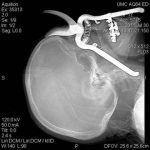For decades, the standard of care for irrigation and debridement (I&D) of open fractures has been within 8 hours of injury. There is a growing body of orthopedic literature that says this isn’t necessarily so.
A paper being presented at the AAST meeting in Chicago next week retrospectively looked at their experience with early (<8hrs) vs late I&D in a series of 248 patients. They looked at infection rates stratified by time and upper vs lower extremity.
They found that the infection rates overall were not significantly different. However, when subgrouped by extremity and higher Gustilo type >= III, they noted that both delayed I&D and Gustilo type correlated with infection risk. For the upper extremity, only Gustilo type >= III correlated with a higher infection rate.
The authors concluded that all lower extremity open fractures should be dealt with in the 8 hour time frame, whereas upper extremity fractures can be delayed for lower Gustilo classes.
Bottom line: I don’t necessarily buy into all the results from this small study. The orthopedic literature has already refined this concept. At Regions Hospital, we allow up to 16 hours to I&D for open fractures up to and including Gustilo class IIIA. Above that, the 8 hour rule is followed. We periodically review our registry data on all open fracture patients to make sure that the extended time frame patients are not experiencing an increase in wound complications. And they haven’t in our 8 year experience in handling them this way.
Refresher on the Gustilo classification system:
- Class I – open fracture, clean wound, <1cm laceration
- Class II – clean wound, laceration >1cm with minimal soft tissue damage
- Class IIIA – clean wound, more extensive soft tissue damage or laceration, periosteum intact, minimal contamination
- Class IIIB – extensive soft tissue damage with periosteal stripping or bone damage, significant contamination
- Class IIIC – arterial injury without regard for degree soft tissue injury
Reference: Open extremity fractures: does delay in operative debridement and irrigation impact infection rates? AAST 2011 Annual Meeting, Paper 22.


